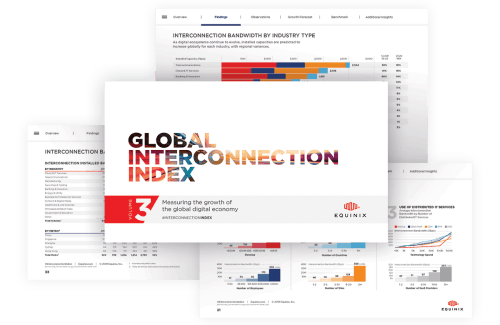The growing adoption of technologies such as IoT, virtual and augmented reality as well as 5G in Asia Pacific is putting a lot of pressure on the demand for interconnection bandwidth, and service providers are responding well to the challenge by making more capacity available to enterprise customers.
According to the latest Global Interconnection Index (GXI), an annual study published by Equinix, interconnection bandwidth in the region is expected to grow at 56% CAGR to exceed 3,825 Tbps by 2022, contributiong 29% of the global capacity.
Among industries, Cloud and IT services is expected to consume the most interconnection bandwidth, reaching 914 Tbps in Asia-Pacific, which is forecast to outpace growth (50% CAGR) of clouds in all other regions. Hong Kong is expected to see the second fastest interconnection bandwidth growth in the region, increasing at 55% CAGR from 2018 to 2022.
In addition, a separate independent survey commissioned by Equinix of more than 2,450 global senior IT professionals, including more than 100 senior IT professionals in Hong Kong, shows that 60% of Hong Kong organisations are currently expanding into new regions, countries or metros, and 66% of them plan to use virtual connections to support their expansions.
“People, software and machines are creating and consuming data faster and in all the places where we work, play, and live,” said Rick Villars, research vice president – data center & cloud, IDC.
He added: “The significant increase in data created, aggregated and analysed in these new locations is contributing to a major shift away from deploying IT in traditional corporate datacenters. Enterprises need access to robust, modern datacenter facilities near the edge locations where businesses want to deploy dedicated infrastructure and interconnect to the increasing number of clouds, customers and partners that are at the core of digital transformation efforts.”
Fertile ground for technological development
According to Jeremy Deutsch, president of Asia Pacific at Equinix, the region has become a fertile ground for technological development.
“We are excited to see the proliferation of 5G, IoT, VR and AR provide the impetus for the enormous growth of interconnection bandwidth in the region,” he said. “Being interconnected has never been so important for enterprises seeking to keep up with customer expectations which often require massive volumes of data to be processed and analysed at the edge, within a matter of seconds.”
“That is why Equinix continues to be committed to staying ahead of evolving customer needs and supporting them in accelerating their digital transformation journey,” Deutsch added.
Below are some of the key findings of the GXI study:
The ability to exchange large volumes of data through interconnection is essential to compete in the digital economy
- The Equinix survey found that almost half of global IT decision-makers (46% in Hong Kong) believe interconnection is a key facilitator of digital transformation, and nearly half of all global IT decision-makers (45% in Hong Kong) believe interconnection can help their business to gain competitive advantage within the marketplace.
Distance is the biggest performance killer for digital business
- Deploying direct, private connections at the edge propels both application performance and user experience.
- According to the Equinix survey, more than one-third of global IT decision-makers (40% in Asia-Pacific and 50% in Hong Kong) are using interconnection to increase speed of connectivity.
Leading businesses are gaining competitive advantage using a combination of key interconnection deployment models
- Interconnecting to multiple network providers across multiple edge locations is the most prominent use case for interconnection bandwidth and is expected to grow 4x by 2022.
- Interconnecting to multiple clouds and IT services across multiple edge locations and cloud regions represents the next largest and fastest use of interconnection bandwidth and is predicted to grow 13x by 2022.
- Interconnecting to digital business partners for financial services, content and digital media and supply chain integration makes up the remainder of interconnection bandwidth use cases and is forecasted to grow 5x by 2022.



